Part IV:
George Melies is Tripping on the Moon
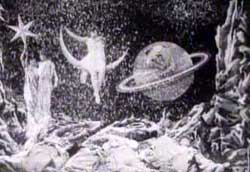 In 2002 a well preserved copy of A Trip to the Moon was discovered in a barn. Uniquely it is a hand-tinted copy, & it includes an additional closing sequence of a parade in honor of the moon explorers. The best restored version already widely in circulation lacks the closing scene, lost for nearly a century, & is black & white, as it was usually seen even when it was new. In 2002 a well preserved copy of A Trip to the Moon was discovered in a barn. Uniquely it is a hand-tinted copy, & it includes an additional closing sequence of a parade in honor of the moon explorers. The best restored version already widely in circulation lacks the closing scene, lost for nearly a century, & is black & white, as it was usually seen even when it was new.
A Trip to the Moon is Melies's most famous film, & one of his most elaborate. It is well in advance of its day, & a little hard to comprehend how Melies could've done it in 1902, a time when films were almost always les than three minutes long. No space voyage film equalled it or added anything particularly new until Fritz Lang's Woman on the Moon (1929), & there were plenty of candidates that had already tried.
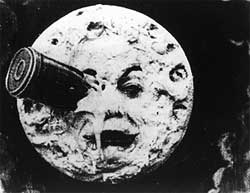 Melies' parody of Jules Verne would be copied by many other filmmakers in the next several years, as in Gaston Velle's Voyage Around a Star (Voyage autour d'une etoile, 1906), & others even less remembered. As late as Things to Come (1936) Melies' idea of a canon as method of reaching space was being repeated. Melies' parody of Jules Verne would be copied by many other filmmakers in the next several years, as in Gaston Velle's Voyage Around a Star (Voyage autour d'une etoile, 1906), & others even less remembered. As late as Things to Come (1936) Melies' idea of a canon as method of reaching space was being repeated.
Sometimes it would go beyond influence into remake or plagiarism, as the Edison Manufacturing Company just swiped & re-edited Melies' film.
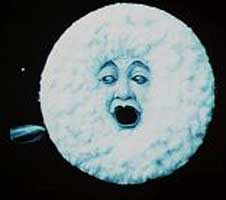 Lubin Manufacturing Company released another take on A Trip to the Moon in 1914, written & directed by Vincent Whitman, a work of silent animation which alas does not survive. Lubin Manufacturing Company released another take on A Trip to the Moon in 1914, written & directed by Vincent Whitman, a work of silent animation which alas does not survive.
It is thought not to have related to Melies film, though it would seem impossible for Melies' original not to have been an influence since it was one of the world's most famous films.
An anonymous author for the Italian Wikipedia asserted that Whitman's film was close enough an imitation to be co-credited to Melies in its Italian release as Viaggio nella Luna, & indeed a search of Italian websites finds the co-credit repeated in several locations, as well as the recurring assertion Whitman based his animated film on Jules Verne.
But Joe Eckhardt, author of The King of the Movies: Film Pioneer, Siegmund Lubin (Fairleigh Dickinson University Press, 1997) informed me it just isn't related to Melies' film, nor related to Verne, judging by a synopsis in an advertising bulletin which is apt to remain the most we'll ever know of that version.
Segundo de Chomon's A Trip to the Moon (La Voyage dans la Lune, 1909) however definitely was a scene-for-scene remake of Melies' film.
Chomon was a pioneering genius of early filmmaking himself (see Films of Segundo de Chomon). But his remake of Melies' moon voyage does not prove it, being in every scene inferior to the original, so that right from the begnnings of cinema, the rule of thumb that remakes tend not to be as good as the originals was already the case.
I've reproduced just the "moon pie-face" from Chomon's version among the photos on this page, for comparison to the iconic rocket-in-eye moonface from Melies original. Similar comparisons in which Chomon falls far short could be observed with any sequence.
Melies himself would copy it to some degree, more originally & in new contexts, in The Quest of the North Pole (La Conquete du pole nord, 1912) with the ice-monster sequence duplicating the monstrous head of the moon-monster.
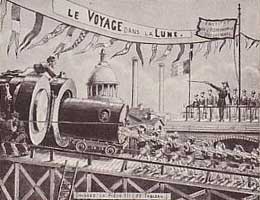 Melies' The Voyage through the Impossible (Le Voyage a travers impossible, 1904) does for the Sun what the 1902 film did for the Moon. Melies' The Voyage through the Impossible (Le Voyage a travers impossible, 1904) does for the Sun what the 1902 film did for the Moon.
And to some extent A Trip to the Moon is kind of a prequel to Melies' perverse The Eclipse: The Courtship of the Sun & the Moon (1907).
As Melies' film opens, a conference of astronomers get into a fight about the possibility of a trip to the moon. Eventually the conference is calmed & select members prepare for a moon journey led by Professor Barbenfouillis, played by Melies himself.
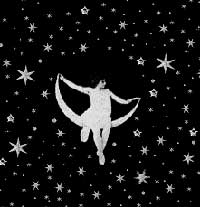 We then view the construction of the bullet-ship. The selected astronomers climb into the bullet which is loaded into a giant cannon. As the bullet-ship approaches the moon, a face appears, & the ship crashes into the left eye. We then view the construction of the bullet-ship. The selected astronomers climb into the bullet which is loaded into a giant cannon. As the bullet-ship approaches the moon, a face appears, & the ship crashes into the left eye.
The astronomers climb out of the bullet & party about the landscape, watching the Earthrise, then lay down on the landscape & while they sleep. An exhibition of astronomical events occur, accompanied by celestial maidens.
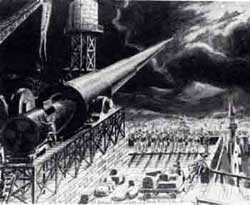 The astronomers are suddenly awakened by a snowstorm, so they climb into the moon's interior to get warm. The astronomers are suddenly awakened by a snowstorm, so they climb into the moon's interior to get warm.
They come to a garden of giant mushrooms. One of the astronomers has his umbrella with him, & when he opens it, it turns into an additional mushroom.
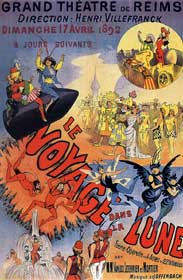 They then get in a bit of a war with the moon people, these being the Selenites from H. G. Welles' 1901 novel First Men in the Moon. They then get in a bit of a war with the moon people, these being the Selenites from H. G. Welles' 1901 novel First Men in the Moon.
Rather than Welles, however, the larger inspiration for this fantasy is Jules Vernes' 1872 From the Earth to the Moon (De la Terra a la lune, 1872), indirectly through the Jacques Offenbach adaptation that had been a raging success on Paris's fin de siecle opera stage.
A poster for the Offenbach opera Le Voyage dans la Lune (1875) for an 1892 production is reproduced near this paragraph. It could well have been recycled in 1902 for the film so overlapping are the designs, for it was the spectacle of the opera Melies set out to capture on film, with his camera-trick approach that could never be done life on stage.
As the film's climax approaches, our captured moon explorers are taken to the throne room of the king, whom one of the astromers kills. The murderous space voyagers run back to the bullet-ship. Since they don't have a cannon to shoot themselves back to the Earth, they push their ship off the moon's ledge & plunge into the sea, to be picked up by a passing steamship.
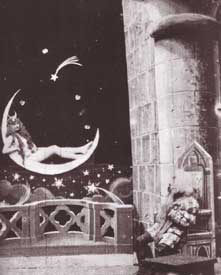 A Trip to the Moon is repeatedly declared to be "the very first" science fiction film. Quite a few s-f films predate it in reality, but A Trip to the Moon is at least the first international megahit of science fiction. When Melies opened his New York offices he well knew this was his most commercially potent movie. A Trip to the Moon is repeatedly declared to be "the very first" science fiction film. Quite a few s-f films predate it in reality, but A Trip to the Moon is at least the first international megahit of science fiction. When Melies opened his New York offices he well knew this was his most commercially potent movie.
Sad to say, Thomas Edison (a very bad man in many ways in his maltreatment of many people) had already pirated it, & Melies had not the legal wherewithal to invest in years of court battles over the theft. While Edison made major profits off Melies' moon journey, Melies never made a cent in America from this great film.
Melies had made an earlier science fantasy. Not long after purchasing the Robert Houdin Theatre he was already producing science fiction for the stage, his earliest very like Les Farces de la Moon. It provided the basis of his early film The Astronomer's Dream La Lune a un metre; aka, Le Reve d'un astronome, 1899), a fragment of which can be seen excerpted in the documentary Magic of Melies.
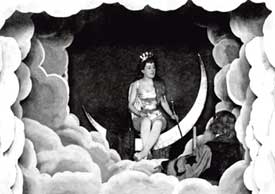 An astronomer (in the stage version he was none other than Nostradamos) has a roof-top observatory, where he has an unexpected encounter with the devil, until the fiend is banished by a celestial fairy (more than once before all events conclude). An astronomer (in the stage version he was none other than Nostradamos) has a roof-top observatory, where he has an unexpected encounter with the devil, until the fiend is banished by a celestial fairy (more than once before all events conclude).
The beautiful moon-maiden (Jehanne D'alcy) lounges on a crescent moon. She descends to the observatory, a temptation to the eager scientist, but she reascends before he can do anything with her.
The full moon is male, & is something of a goblin which expands into the astronmer's observatory & gulps him down in one bite, chews him up, & spits out the pieces, to be restored bit by bit by the moon-maiden before he awakens over the book he had been reading, probably thinking it was all a dream, but we saw it, it happened. This miracle of events concludes in only three minutes.
copyright © by Paghat the Ratgirl
|
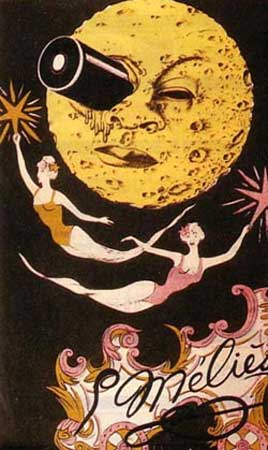

 Melies' parody of Jules Verne would be copied by many other filmmakers in the next several years, as in Gaston Velle's
Melies' parody of Jules Verne would be copied by many other filmmakers in the next several years, as in Gaston Velle's  Lubin Manufacturing Company released another take on A Trip to the Moon in 1914, written & directed by Vincent Whitman, a work of silent animation which alas does not survive.
Lubin Manufacturing Company released another take on A Trip to the Moon in 1914, written & directed by Vincent Whitman, a work of silent animation which alas does not survive. Melies'
Melies'  We then view the construction of the bullet-ship. The selected astronomers climb into the bullet which is loaded into a giant cannon. As the bullet-ship approaches the moon, a face appears, & the ship crashes into the left eye.
We then view the construction of the bullet-ship. The selected astronomers climb into the bullet which is loaded into a giant cannon. As the bullet-ship approaches the moon, a face appears, & the ship crashes into the left eye. The astronomers are suddenly awakened by a snowstorm, so they climb into the moon's interior to get warm.
The astronomers are suddenly awakened by a snowstorm, so they climb into the moon's interior to get warm. They then get in a bit of a war with the moon people, these being the Selenites from H. G. Welles' 1901 novel First Men in the Moon.
They then get in a bit of a war with the moon people, these being the Selenites from H. G. Welles' 1901 novel First Men in the Moon.
 An astronomer (in the stage version he was none other than Nostradamos) has a roof-top observatory, where he has an unexpected encounter with the devil, until the fiend is banished by a celestial fairy (more than once before all events conclude).
An astronomer (in the stage version he was none other than Nostradamos) has a roof-top observatory, where he has an unexpected encounter with the devil, until the fiend is banished by a celestial fairy (more than once before all events conclude).